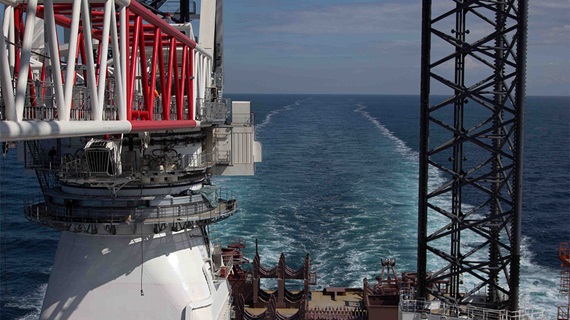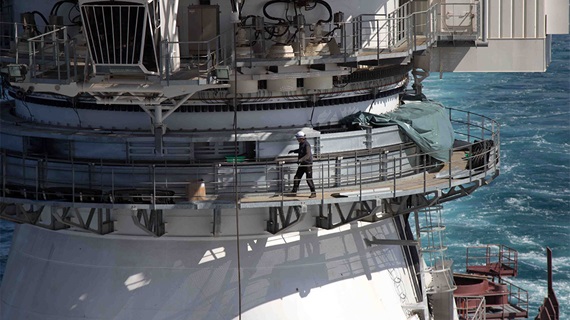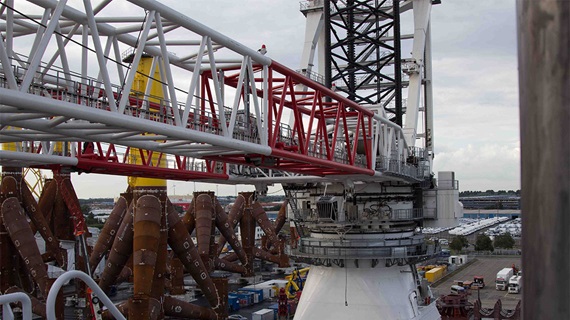Energy chain wrapped around the crane leg
New energy supply concept for heavy-duty ship cranes
Heavy-duty CAL-series Liebherr rotary cranes are used on installation ships for offshore wind turbines. They can lift components weighing up to 1,500 tons. Energy transfer through the slewing ring is ensured by an innovative concept connecting two energy chains, allowing the boom to rotate up to 900 degrees.
Profile
- What was needed: "Multi-rotation module", also known as "RBR", consisting of two energy chains of type E4.1, chainflex cables, steel construction
- Requirements: Energy supply to the boom of the system, sensitive environmental conditions due to use at sea
- Industry: Crane construction
- Success for the customer: Completely new energy supply system specifically designed for this application, advance testing of the application in the laboratory, complete delivery incl. pre-assembly, harnessing and delivery

Problem
A "crane around the leg", is a completely new crane class from Liebherr-Werk Nenzing GmbH, a world-renowned specialist for ship cranes. It was developed for so-called installation vessels, e.g. the "Innovation", which installs offshore wind turbine generators (WTGs) at sea.The "Innovation" picks up three tripods in the harbour, which serve as foundations for offshore wind turbines and weigh up to 850 tons each. It travels to the designated location and takes up its position there with centimetre precision with the help of Azipod drives and bow thrusters - and in such a way that it can set all three wind turbine foundations from this location. There, the installation vessel extends its four lifting legs over a length of up to 50 metres to the seabed so that it has a secure footing and is independent of the swell. A heavy-duty crane mounted on the ship with a lifting capacity of up to 1500 tons lifts the tripods from the ship and places them on the seabed. One of the design challenges for this new crane type was the energy supply to the boom. The most obvious solution - a busbar system on the outer jacket of the lifting leg - is not practicable under the environmental conditions of offshore use because it can cause malfunctions due to splash water. The same effect is possible with an enclosed busbar system because the temperature differences cause condensation.
Solution
The Liebherr designers in charge of the implementation requested an energy supply system from igus. The answer from igus: Two energy chains are laid around the lifting leg and connected via a moving end. The result is a very robust energy supply system that has proven itself under extreme conditions, requires little space and has a turning radius of 900 degrees. As this idea had never before been realised in practice, Liebherr initially placed the engineering order with igus to build the system on a scale of 1:5 and test it extensively. After successful completion, further full-scale tests were carried out in the company's own test laboratory.The final system, which igus refers to as a "multi-rotation module" or "RBR", consists of two type E4.1 energy chains with a width, or in this case height, of 650 millimetres and a width of 108 millimetres. The lower chain is 33.90 metres long, the upper 23 metres. The chains work in reverse and are mounted on rollers, the upper one rotates freely. The two chains are connected by three moving ends. The cables used are different variants from the chainflex product range from igus, which were developed from the ground up for moving applications. In addition to the main power supply and the necessary signal cables, fibre optic cables for a camera were also integrated to allow the ship's captain to view the crane's working area. The cables are 81 metres long, the complete energy supply system was pre-assembled, harnessed and delivered by igus as a ready-to-install system - including the steel structure with an outer diameter of 14.40 metres.

